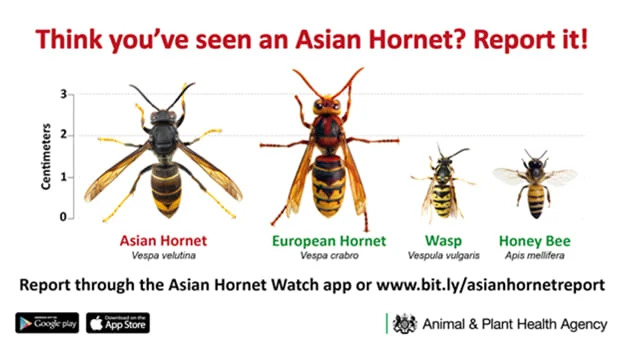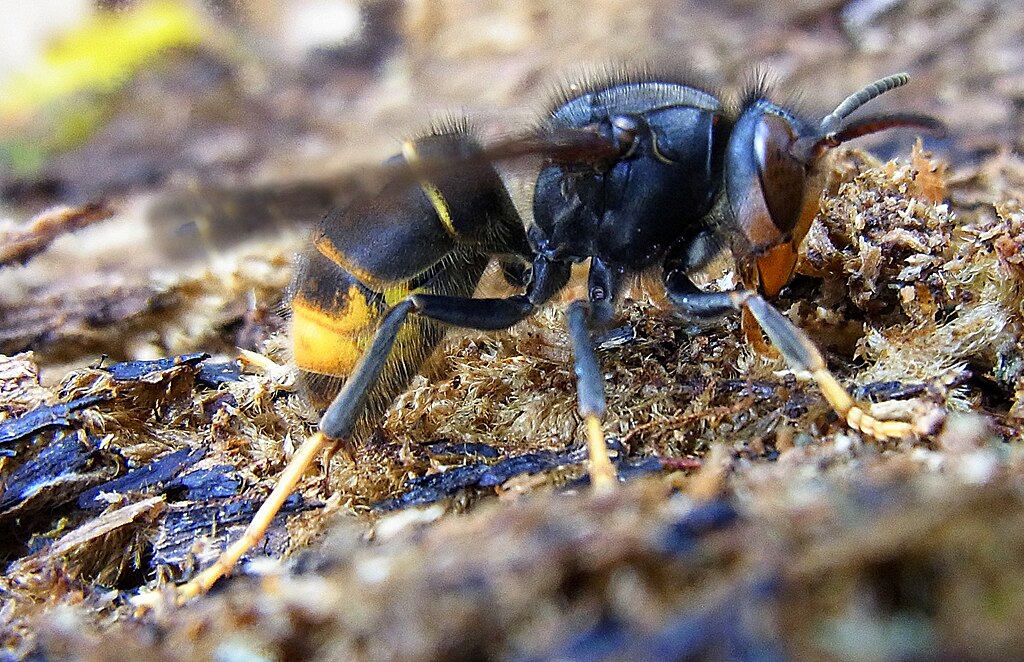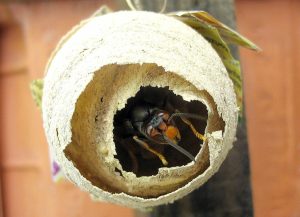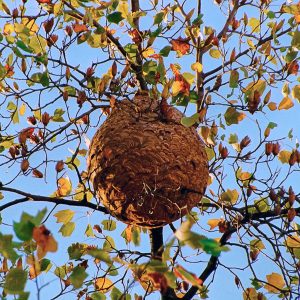Asian hornets, Vespa velutina, have spread across Europe and have now arrived in Britain. They’re a particular threat to honey bees. Our help forum administrator ‘Aunt Sally’ has produced this Asian Hornet advice guide to raise awareness and give advice about this dangerous, invasive pest species.
Asian hornets are thought to have arrived in Bordeaux, France from China in a container of pottery in 2005. They quickly spread across France and into continental Europe. Reported in Spain in 2010, Belgium in 2011, Germany in 2014the Channel Isles in 2016 and were first spotted in the UK in late 2016.
Gloucestershire, Somerset, Devon, Dorset, Lancashire, Cornwall, Hull, Hampshire, Surrey, Kent, Suffolk and Staffordshire have all had sightings of Asian hornets.
Once established their growth rate is exponential. If allowed to establish they will be near impossible to eradicate in the UK
Report Sightings
 If you think you have seen an Asian hornet, please notify the Great British Non Native Species Secretariat (NNSS) immediately. In the first instance sightings should preferably be reported through the free Asian Hornet Watch App, available for Android and iPhone. There is an online Asian hornet reporting form here.
If you think you have seen an Asian hornet, please notify the Great British Non Native Species Secretariat (NNSS) immediately. In the first instance sightings should preferably be reported through the free Asian Hornet Watch App, available for Android and iPhone. There is an online Asian hornet reporting form here.
You can also send any suspect sightings to the Non Native Species email address alertnonnative@ceh.ac.uk.
When reporting a photo, the location of the sighting and a description of the insect seen should be included if possible.
Warning
Do not under any circumstances disturb or provoke an active hornets’ nest. Hornets will swarm attack if the nest is disturbed. They are much larger than wasps or honey bees and their sting more serious. Several people in Europe have died due to multiple Asian hornet stings
How to Identify Asian Hornets
The most distinctive feature of the Asian hornet is the yellow ends to the legs. The Asian hornet is also generally slightly smaller and much darker than the native European hornet. The thorax (behind the head) is entirely dark but the abdomen has a yellow stripe near the tip.

Asian Hornet, Vespa veluta
Lifecycle of the Asian Hornet
Primary nest

Asian hornet in primary nest.
© Gilles San Martin Wiki Commons (CCBY-NC 2.0)
The Asian hornet queens begin building their primary nests in early spring. This nest is usually about the size of a tennis ball.
At this stage, it is difficult to tell the difference between a wasp’s nest and an Asian hornet’s nest as the entrances for both are at the bottom and therefore look similar. Primary nests will be found in places such as porches, sheds and other protected areas.
Observe the nest to see if it’s a hornet or wasp nest. Do not go near the nest or touch it as the hornets may attack you. If it is a hornets’ nest DO NOT try to remove it yourself: seek expert advice and help.
In late spring the queen lays eggs and feeds the larvae when they first emerge.
Secondary nest
When the first generation of workers reaches the adult stage in early summer there may be as many as 50-100 individuals. They may then build a secondary nest nearby.

Secondary or main Asian Hornet nest. This one is 10m high in a tree in Portugal, It was only spotted in autumn when the tree was shedding leaves.
Paula Jorge, CC BY-SA 4.0
Secondary hornet nests usually have the entrance on the side. The nest is often situated in a high place but can be in hedges or brambles. Most of the hornets will move to the secondary nest and this will also be their home through to the winter.
During early summer the workers start visiting flowers and trees to bring back nectar for carbohydrate and they also prey on other insects for protein. The wing muscles of insects, including honey bees are a good source of protein on which to feed the hornet larvae.
Each Asian hornet nest can have up to 10,000 workers and produce around 300 queens by the end of the year each capable of producing a new nest next year.
The Asian hornets’ nest is at its maximum size in late summer. The workers prey on insects and it is at this time of the year that honey bee colonies are at their most vulnerable. Honey bees are an easy source of protein for Asian hornets.
Each Asian hornet is capable of taking 25-30 honey bees a day back to the nest. The bees become so frightened that they will no longer fly out of their beehives and the queen will stop laying. The colony will become weaker and eventually may collapse and die.
Danger
Do not attempt to remove a secondary nest. The hornets are very dangerous and WILL attack. Obtain expert help.
The first reproductive adult Asian hornets emerge around late Autumn with the males emerging first followed by all the new queens. These will establish new primary nests and secondary nests in due course.
Further Information on Asian Hornets, Vespa velutina
Further general information on Asian Hornets, Vespa velutina is available on Wikipedia
BeeBase has rolling updates on Asian hornets from their Beekeeping news page




In France advice is to put traps of sugary syrup up when queens begin to be active – February in the Correze. Also bee keepers found chickens effective at protecting hives. They eat the wasps as they hover around the entrances, apparently.
They’re already established in France but here in the UK we’re hopeful of preventing them from establishing, so much different advice and approach.